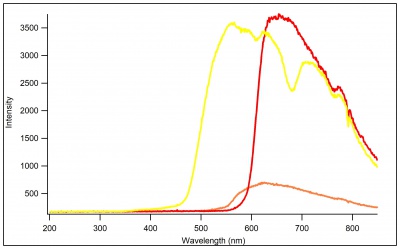Difference between revisions of "Stained Glass"
Jump to navigation
Jump to search
(Created page with "=Background= =Experiment Description= =Data= 400px") |
|||
| Line 1: | Line 1: | ||
| + | By Emily Currens | ||
| + | |||
| + | ''Senior Biochemistry Major'' | ||
| + | |||
| + | ''Spring 2019'' | ||
| + | |||
=Background= | =Background= | ||
=Experiment Description= | =Experiment Description= | ||
| + | Three different colored stained glass bottles (red, orange, and yellow) were used for this activity. A tungsten bulb was used as the light source. The PDA detector was placed inside the bottle while the light bulb was directed at the bottle. The experiment was conducted in a room with little light exposure. | ||
=Data= | =Data= | ||
| − | [[File:Stained Glass Data.jpg|400px]] | + | |
| + | [[File:Stained Glass Data.jpg|400px|Figure 1: Intensity of light from a tungsten light bulb transmitted through different colored stained glass bottles. The red spectrum represents the red bottle, the yellow spectrum correlates with the yellow bottle, and the orange spectrum represents the orange bottle.]] | ||
| + | |||
| + | =Sources= | ||
| + | |||
| + | [[Light_lab_Pchem|Return to Light Lab]] | ||
Latest revision as of 21:17, 31 January 2019
By Emily Currens
Senior Biochemistry Major
Spring 2019
Background
Experiment Description
Three different colored stained glass bottles (red, orange, and yellow) were used for this activity. A tungsten bulb was used as the light source. The PDA detector was placed inside the bottle while the light bulb was directed at the bottle. The experiment was conducted in a room with little light exposure.
